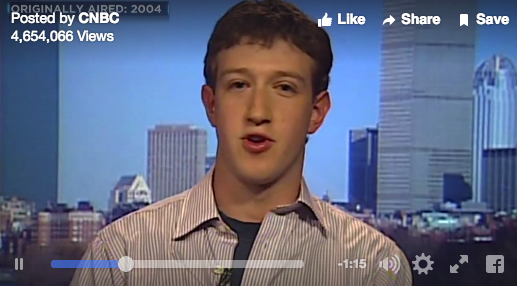CEO Brand Leadership: How Vision Drives Brand Growth
/0 Comments/in Brand Culture, Brand Leadership, Brand Strategy, Customer Service, Entrepreneur /by Lorraine CarterIn shaping a brand, CEO brand leadership plays a critical role as the visionary behind the brand. Leaders with vision are aspirational; they stretch the imagination and they look to the future. They understand that a vision is not just a statement; it’s a process. It’s alive. It changes as the world presents new opportunities. True leaders embody and define a brand vision and culture, which must be shared and cultivated to exist.
It’s worthwhile examining lessons from three of the most influential, visionary, and successful CEOs of our times:
- Jeff Bezos continues to break records leading the fastest-growing company in world history.
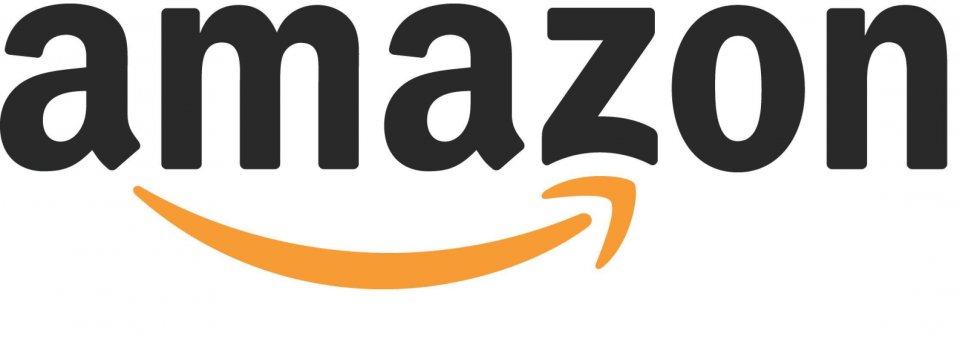
Image via Amazon
- Steve Jobs developed the first personal computer and laid the foundation for the world’s highest-valued company.

Image via Apple
- Bill Gates, the world’s wealthiest individual, built the world’s first software company and is now running the world’s largest private charitable foundation.[1]

Image via Microsoft
Not all visionary CEOs are corporate giants, of course. Sectors such as nonprofits, services, and even political parties also require leaders with exemplary vision. And it’s not uncommon for entrepreneurs and startups to be guided by a founder whose passion results from personal experience that is shaped into a brand vision.
Related: CEO Brand Leadership – How Does Your Leadership Impact Your Brand?
Visionary Branding: CEO Brand Leadership Must See Tomorrow
Regardless, in all cases it is the CEO’s responsibility to own the vision, to effectively communicate the vision, to provide the resources to deliver the vision, to authentically support the vision, to engage in dialogue with stakeholders, and to continually refresh and drive the brand vision.
Branding that reflects a vision is key to a company’s long-term survival and market leadership and success. It may be time for you shape your brand strategy to rebrand, refresh or relaunch. Talk to us about taking the next step to re-shape your vision and align your branding to ensure its long term health and growth. |
Related: A Rebranding Strategy Guide for Brand Owners and Managers
Strong Brand Culture: Shaped by The CEO’s Brand Leadership Vision
It’s well known in Silicon Valley circles that in the months leading up to Facebook’s IPO in 2012, a slogan was painted on the wall at headquarters proclaiming, “Done is better than perfect.” That underscores the company culture in a brand that didn’t exist before 2004. Now Facebook has over 1.86 billion monthly active users run by a 32-year-old founder and CEO who ranks as the world’s fifth wealthiest individual.[2]
Related: 10 Branding Tips From Silicon Valley on How to be a Successful Startup Brand
“When we first launched we were hoping for maybe 400 or 500 people…so who knows where we’re going next?” a 19-year-old Mark Zuckerberg told CNBC about his new college social networking site that had achieved 100,000 users in 2004. “Maybe we can make something cool.”
While the words “company culture” are bandied about quite a bit, one Melbourne-based international consultant cuts through the jargon to explain the concept succinctly. “For example, if it is 5 o’clock and you are walking out the door and the phone rings – if you care about the goals of the business you will pick up that call.”[3]
That level of employee care, explains Didier Elzinga, CEO of Culture Amp, has its roots in the leadership. While the CEO cannot sit in on every meeting, corporate culture is intrinsically linked to leadership and trust.
Companies and workers either have it or they don’t, says Elzinga, after studying 600 firms representing more than two million employees.
Ultimately, successful leaders shape their company culture, they do not allow the company to shape their vision. Modern business analyses indicate that “the way things work around here” is driven day-to-day from the top, deeply embedded in processes, reward systems, and behaviors.[4]
Related: What’s a Cult Lifestyle Brand and How do You Create One?
As a case in point, we only need to look to the headlines following events of April 2017, when United Airlines’ CEO made a reportedly bad situation infinitely worse by publicly doubling down on company culture, citing terms and conditions instead of responding with sincere apologies. “I’ve learned,” says Oscar Munoz, about what he refers to as his “shame and embarrassment.”
Brand Survival: CEOs Must Keep the Ship Afloat
In the influential bestseller, “The Innovator’s Dilemma: When New Technologies Cause Great Firms to Fail,” author Clayton M. Christensen noted that companies must consistently disrupt their existing product lineup with “the next new thing” in each of the categories in which they compete.[5]
Related: The Power of Disruptor Brands and Challenger Brands
To ensure survival, a CEO must see tomorrow and infuse (and re-infuse) the brand with an evolving vision. Today, this is even more critical than when Christensen’s book was first published in 1997. Astonishingly, the average life expectancy of a Fortune 500 company has declined from around 75 years half a century ago to less than 15 years today…and it is declining all the time.[6]
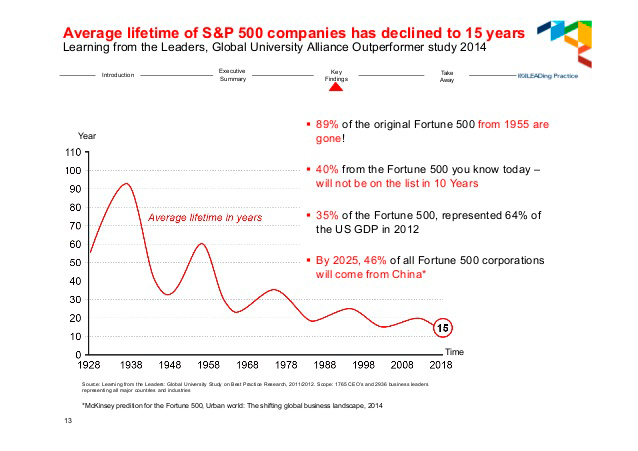
Brand Vision: When the CEO is Customer-Centric
Amazon, Apple, Microsoft: Dedication to a superior customer experience is the thread shared by extraordinary leaders like Jobs, Bezos, and Gates.
Jeff Bezos founded Amazon.com to be the “Earth’s Most Customer-Centric Company.” When in 2005, CustomerThink awarded the internet giant with a customer-centric leadership award, Amazon responded with, “It is simply in our DNA to approach our business by starting with the customer and working backward, and for the past 10 years we have stayed laser-focused on this core principle.”[7]
Bezos says you can have one of 4 primary business focuses:
1. Competitor focus
2. Product focus
3. Business model focus
4. Customer focus
In Bezos’ view, constant customer focus yields the best returns and it’s fundamental to his brand vision and the whole Amazon brand culture. Because customers are endlessly dissatisfied, a company that obsesses about its customers happiness is constantly lifting the bar on the quality of the experience and inventing new ways to please. Together, these actions lead to superior results.
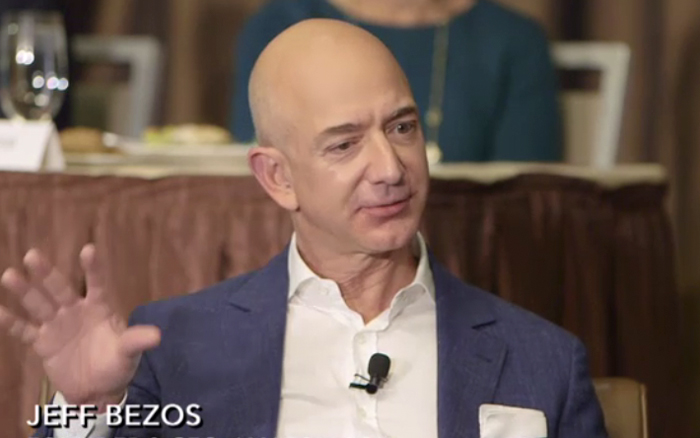
Image via CharlieRose.com
Early Amazon employees could tell you about the empty chair at the conference table, placed there to represent the customer, “the most important person in the room,” according to Bezos. “The thing that connects everything that Amazon does is customer obsession,” Bezos explained in a 2016 interview,[8] recalling that Amazon used to only sell books and he drove the packages to the post office himself. With a net wealth of $75.6 billion, he may have a point.
Related: Top 10 Brands for Customer Experience and What You Can Learn From Them
On his return to Apple 12 years after being fired, speaking at a Worldwide Developers Conference in 1997, Steve Jobs defined what he called “the right path” for his strategy and vision. “What incredible benefits can we bring to the customer? Where can we take the customer? It’s not starting with let’s sit down with the engineers and figure out what awesome technology we have and then how can we market that.”[9]
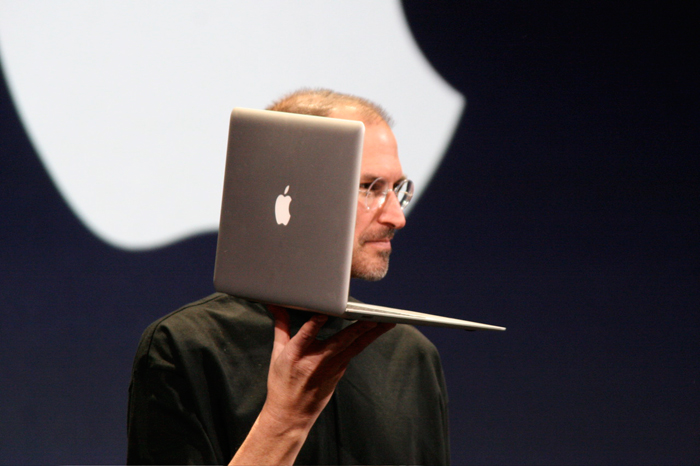
Image via Wikimedia Commons
Throughout his lifetime, this customer-centric approach remained at the heart of Jobs’ laser focus on every detail, in all the touchpoints and design elements of Apple’s products, including even internal ones that cannot be seen.
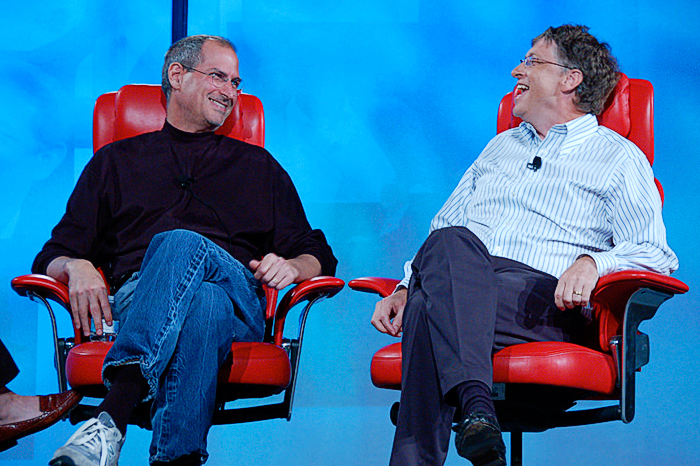
Steve Jobs and Bill Gates (David Geller, flickr 2.0)
Bill Gates on Steve Jobs, “He knew about brand in a very positive sense; he had an intuitive sense for marketing that was amazing.”[10]
And while happy customers are the goal, Bill Gates has commented on his own leadership at Microsoft, “Your most unhappy customers are your greatest source of learning.”[11]
Brand Success: CEO Brand Leadership Vision For an SME
The most important CEO function in a small-to-medium sized business is setting strategy and vision says Rushika Bhatia, Editor of SME Advisor magazine. “Lots of people can help the senior management team develop strategy. Lots more – including the investors and shareholders – can approve a business plan. Yet the actual direction, destination and market positioning can only be set by one person: the CEO.”[12]
In Silicon Valley, venture capitalist Ben Horowitz of Andreessen Horowitz is a startup expert who echoes this view. “The story of the company goes beyond quarterly or annual goals and gets to the hardcore question of why? Why should I join this company? Why should I be excited to work here? Why should I buy your product? Why should I invest in the company? Why is the world better off as a result of this company’s existence? Some employees make products, some make sales; the CEO makes visionary decisions.”[13]
Due to the smaller size of a startup or SME, a CEO is closer to internal functions, all stakeholders, and ultimately, customer experiences. At small-to-medium sized businesses, leaders have greater opportunity for direct control of the organizational climate and brand culture, hence interaction for delivering the vision. CEO advocates of the ‘customer first’ approach can directly influence that vision as the head of an SME.
If you want in-person professional direction to re-evaluate your brand or clarity on how to articulate what your brand stands for so you can sell more effectively and would like to explore working with us then drop us a line to [email protected] or give us a call T: +353 1 8322724 (GMT). We’d be delighted to talk with you.
Alternatively you can also build your brand yourself using our Personality Profile Performer™ programme so you can identify what makes it really different, distinctive and memorable to standout. This is a step-by-step brand building programme, complete with downloads, questionnaires and checklists, to help you build your brand. You can watch a section of the programme here.
Building a Brand From Scratch: An Innovative Ice Cream Story
In 2007, Robyn Sue FIsher had an MBA from Stanford University, no money, and a passion for ice cream. She started selling her Smitten Ice Cream brand on the streets of San Francisco from a Radio Flyer wagon to transport her innovative machinery.
As CEO, she now has three patents on a liquid nitrogen machine, 10 Smitten stores across California and 200 employees. The vision was to produce the best-tasting, wholesome, handmade ice cream from scratch, one scoop at a time, from all natural ingredients, using technology to get old-fashioned flavours.
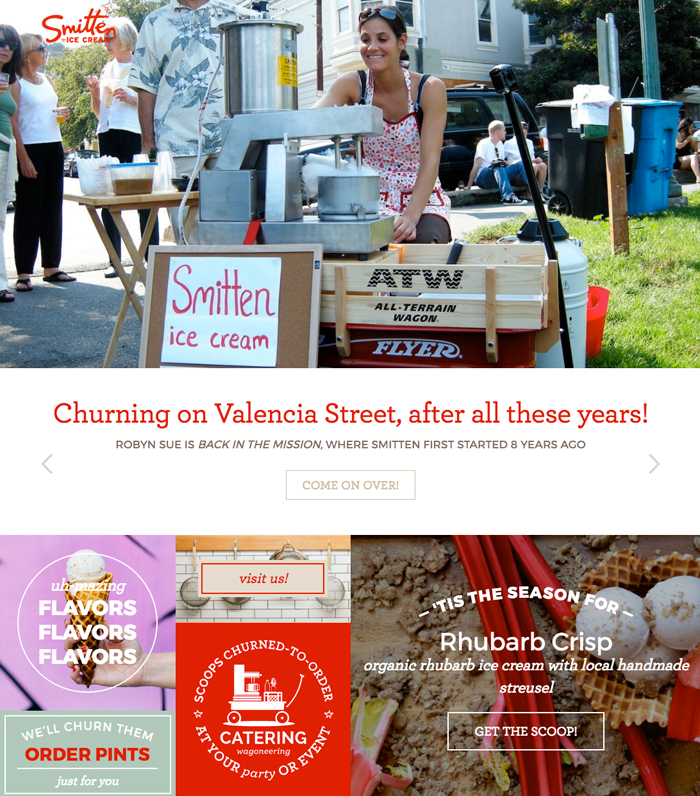
Image via Smitten Ice Cream
In a podcast interview, Robyn says, “I get closer and closer to our amazing people as we grow. A lot of the things that make me sit behind a computer, which is not what I signed up for, can be handed off to people who can do them better than me so I can actually build our culture and be in charge of innovation. Growth enables me to shine and everyone else to take ownership and help steer the company.”[14]
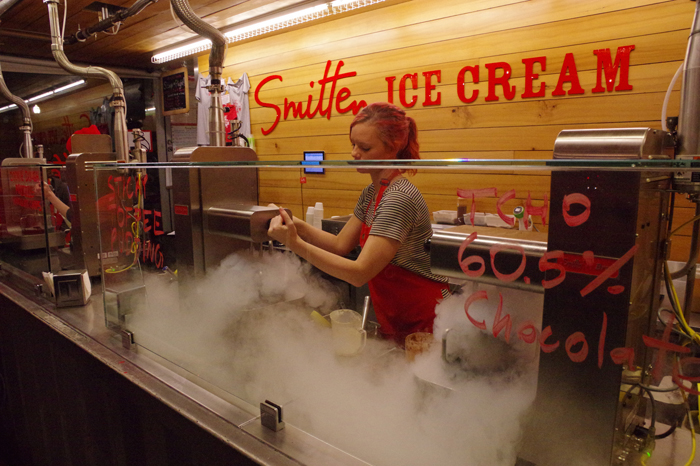
Image via Smitten Ice Cream
Brand Loyalty and Longevity: A Natural Health and Wellness Story
Just one mile from Harvard Square, a husband-and-wife team started a natural health and wellness specialist store after graduating from college in 1974, and have been running Cambridge Naturals ever since. Co-founder Michael Kanter carries the title Chief Visionary Officer, embracing a belief “that strong employees are absolutely vital to a thriving business, and that improving our employees’ standard of living will in turn help our business to grow and prosper.” Leading by example, he has raised the business’ starting hourly pay to considerably above minimum wage plus 100% medical and dental benefits for full-time staff.[15]
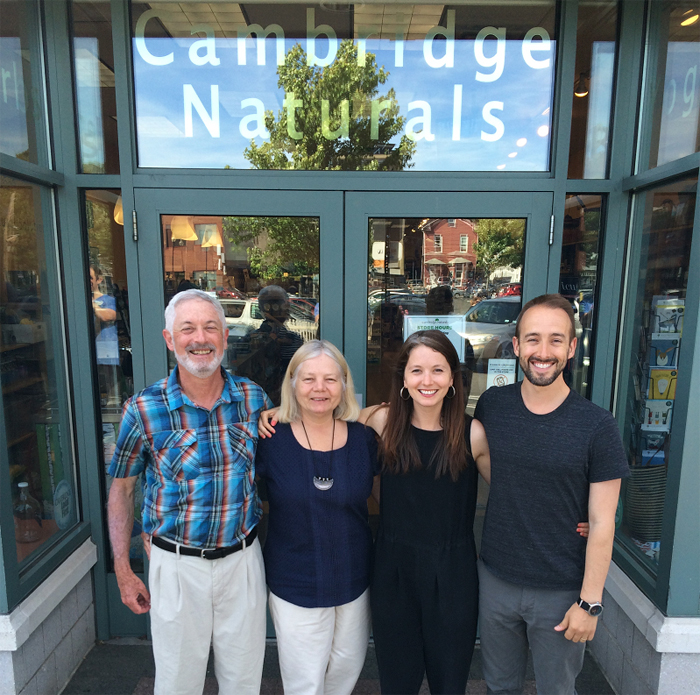
Cambridge Naturals: Family business, Michael Kanter and Elizabeth Stagl with daughter Emily Kanter and son-in-law Caleb Dean
A founding member of Cambridge Local First, Michael has been actively involved in both federal and state campaigns to raise the minimum wage, hosting former Secretary of Labor Thomas Perez in 2014 for a local business roundtable on the impact of wages on employee and business health and success and writing about it for the U.S. Department of Labour Blog.[16]
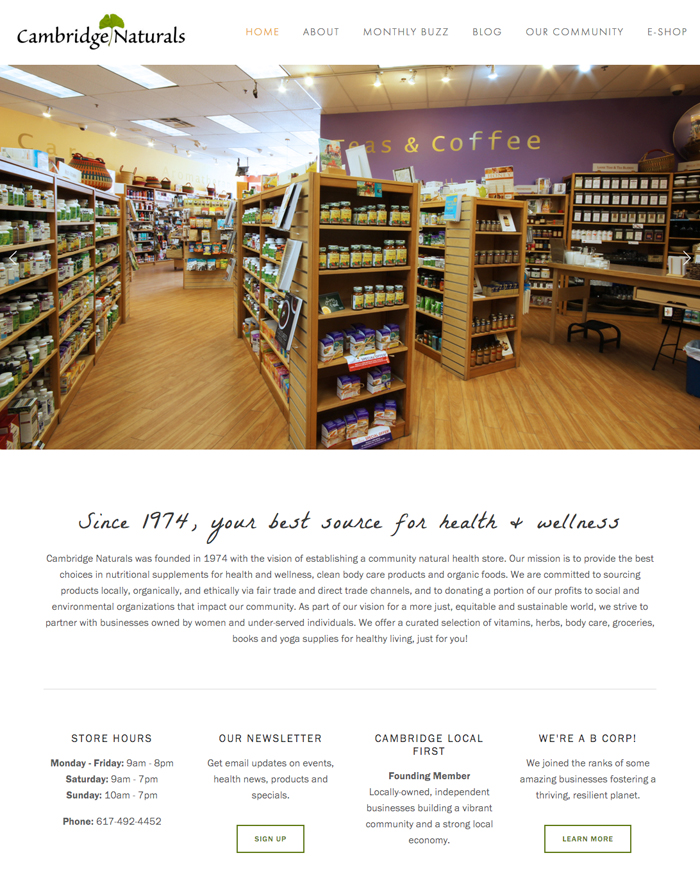
Image via Cambridge Naturals
Michael’s vision extends to consulting for other natural products businesses and speaking at industry trade events about the rewards and the struggles of running a locally-owned, community-oriented business.
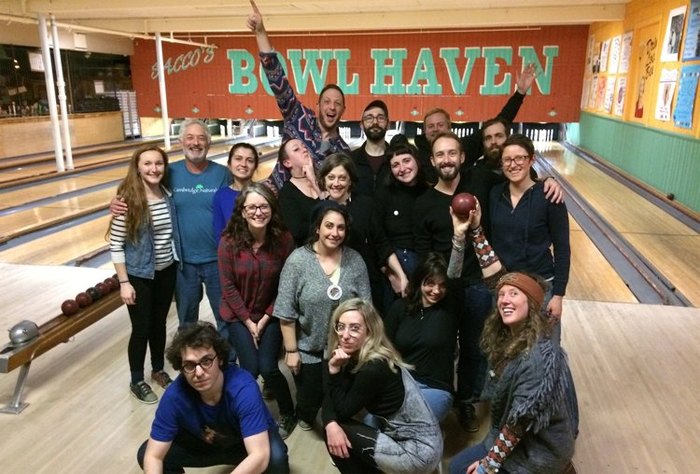
Cambridge Naturals: Company Outing
Ultimate Brand: When the CEO is the Brand
In a family business, a small-to-midsized business, a larger firm, or even an entire nation, a founder and/or CEO’s persona can permeate the brand. Such a personification of brand vision can resonate far more deeply than a logo ever will, a tagline, or an advertising campaign. And it can be kept alive through generations. According to the U.S. Bureau of the Census, about 90 percent of American businesses are family-owned or controlled.[17]
Related: Family Business Branding and The Secret Drivers to Brand Success
Personal infusion or identity crossover can generate iconic status for the brand. Well-known examples of founders and CEOs who have personally underscored brand strength include Henry Ford of Ford Motor Company, innovator Walt Disney of the Disney Company, and entrepreneur Richard Branson, founder of Virgin Group.
The strength of vision from these three futurist dreamers has changed the world. Listen to Walt Disney’s daughter on the emerging vision of her father from the drawing board to Disneyland theme parks for children of all ages.

Image via Walt Disney
Hear Sir Richard Branson connect the dots between airplanes and his vision for space travel by millions of earth dwellers.
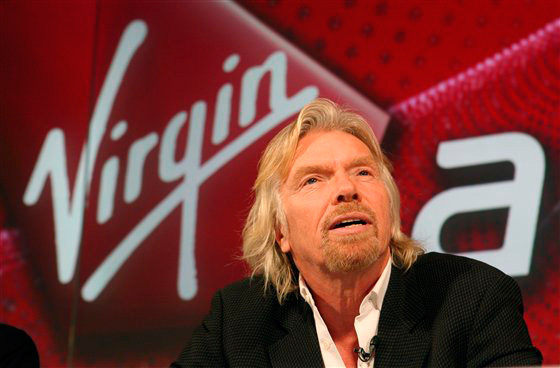
Image via Virgin
An elected head of state is perhaps the best example to most starkly illustrate how a leader’s personal stamp critically shapes a brand, in this case, the brand of a country.
Related: What Brands Can Learn From Political Campaigns
Think of the president of the United States or the prime minister of the United Kingdom, for example, as a CEO. This individual embodies and defines the vision for the national brand — including its perception at home and globally — with massive implications based upon their own individual vision.
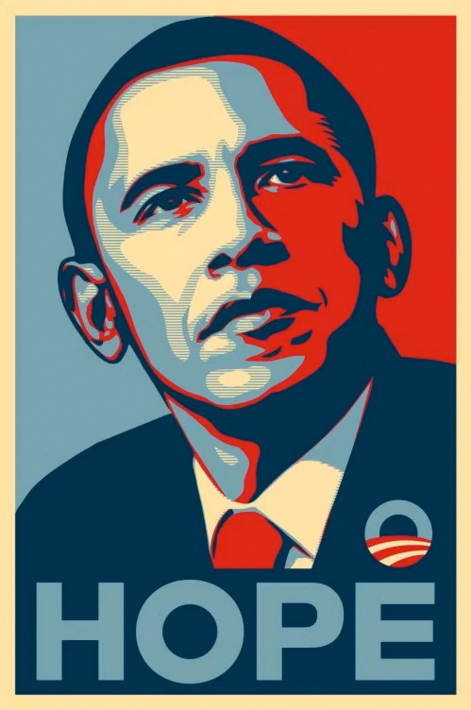
Image via Wikimedia Commons
When you realise that 60% of branding is about perception and only 40% about all the more tangible stuff, be that product or service, then the power of branding really hits home.
Are you a visionary CEO and have you considered?
- Do you feel confident expressing your brand vision succinctly and authentically — what your brand stands for?
- What are the leadership principles you most admire and who embodies them best?
- Do you both ‘talk the talk’ and ‘walk the walk’ as the visionary behind your brand and the face of your brand?
- How does your brand vision continually adapt to changing times?
- How well do you communicate your brand vision to all stakeholders? Can you clearly articulate what makes your brand different compared to your competitors — in terms that are compelling to both customers and stakeholders alike.
- Does your vision feel fresh and futuristic or is your brand ripe for a refresh?
If you need direction and support giving your brand a health check or brand revitalisation feel free to get in touch [email protected] or give us a ring T: +353 1 8322724 (GMT hours).
Alternatively you can also give your brand a health check yourself to identify its strengths, weakness and areas for potential innovation and growth using our Auditing Analysis Accelerator™ programme. This is a step-by-step walk through, complete with downloads, questionnaires and checklists, to help you audit your brand. You can watch a section of the programme here.

Start auditing your brand here
[1] https://www.forbes.com/billionaires/list/2/#version:static
[2] https://www.forbes.com/billionaires/list/2/#version:static
[3] https://www.siliconrepublic.com/jobs/cultureamp-ceo-brand-promise-culture-deliver
[4] https://dupress.deloitte.com/dup-us-en/focus/human-capital-trends/2016/impact-of-culture-on-business-strategy.html
[5] http://changethis.com/manifesto/149.04.LongTermGrowth/pdf/149.04.LongTermGrowth.pdf
[6] https://www.aei.org/publication/fortune-500-firms-in-1955-vs-2014-89-are-gone-and-were-all-better-off-because-of-that-dynamic-creative-destruction
[7] https://www.entrepreneur.com/article/234254
[8] https://charlierose.com/videos/29412
[9] https://www.youtube.com/watch?v=FF-tKLISfPE
[10] http://www.cbsnews.com/news/bill-gates-on-steve-jobs-we-grew-up-together
[11] https://www.surveymonkey.com/blog/2015/02/13/10-inspiring-customer-satisfaction-quotes-and-the-stories-behind-them
[12] http://smeadvisor.com/featured/leading-from-the-front-role-of-the-ceo
[13] https://a16z.com/2010/05/31/how-andreessen-horowitz-evaluates-ceos
[14] http://www.thebigleapshow.com/robyn-sue-fisher
[15] https://static1.squarespace.com/static/5366ed3ee4b0b47b799380bb/t/58500c0920099e4b52133b17/1481640969656/CNPressReleaseDec13+-+FINAL.pdf
[16] https://blog.dol.gov/2017/01/03/why-one-family-owned-business-decided-to-raisethewage
[17] https://www.inc.com/encyclopedia/family-owned-businesses.html
Top 10 Brands for Customer Experience and What You Can Learn From Them
/0 Comments/in Brand Affinity, Brand Champions, Brand Culture, Brand Differentiation, Brand Experience, Brand Health Check, Brand Loyalty, Brand Strategy, Brand Values, Business, Corporate Social Responsibility, Customer Engagement, Customer Service /by Lorraine Carter“If you make customers unhappy in the physical world, they might each tell 6 friends. If you make customers unhappy on the Internet, they can each tell 6,000 friends.” (Jeff Bezos) – CEO Amazon.
89 percent of companies expect to compete mostly on the basis of customer experience in 2016 according to a recent Gartner survey, compared to only 36 percent four years ago. If your customers don’t like the customer experience they have with you, there’s a high probability they won’t buy again and they’re highly likely to share their poor brand experience with everyone they know — online!

Here we’ll take a look at who has been delivering a great customer brand experience and how they’re doing it really well, contrasted with others on the opposite end of the scale — with actionable learnings for you to take away from both.
The latest reports on customer brand performance are eye-openers and worth reflecting on when you review your own brand or give it a customer performance brand health check.
Common Brand Experience Traits for Top Brands
One factor that definitely stands out is steadfast perseverance. What has attracted customers before, and will attract them in the future, is perceived value. The brands that have continued to deliver highly regarded perceived brand value, from a customer perspective, and continued to unwaveringly improve upon it, are ruling the day.
This perceived brand value has nothing to do with affordability but everything to do with user experience, a unique experience that creates strong brand loyalty and engenders long lasting customer brand champions.

Image via http://i.huffpost.com
Who’s Got Exemplary Customer Service Really Covered?
- 1. Amazon
- 2. Apple
- 3. Nordstrom
- 4. Lush
- 5. First Direct
- 6. LL Bean
- 7. Air Asia
- 8. Uber
- 9. Net-A-Porter
- 10. Worldwide Stereo
Let’s take a closer look to see how these brands have a made real difference to their customers’ lives, and consequently massively grown their profits too.
Case Study #1 Amazon – Let the Customer Rule
How Amazon created a brand around its customers?
When it comes to perceived value and web-based customer service, Amazon wins hands down. It has repeatedly demonstrated to the world that, when done correctly, with meticulous attention to detail and tireless focus, they are the byword for customer service. In reality, despite many detractors and ever-growing competition, the retail, or rather the e-tail giant, has proved that customer service is a fine art. It’s no wonder than many fail, despite best intentions.
The core vision
One of the reasons Amazon excels at customer service is because their core vision blends in with their founder’s original mission seamlessly — make customers the primary focus and deliver unflagging perceived value. They’ve built their entire customer service brand strategy, and in extension, their brand around this mission.
USPs:
What stands out first is their incredible returns policy, which is the first thing to reassure the buyer that they will be taken care of, even if they dislike their purchase. In other words, their money is safe, if in doubt.
Another outstanding feature is the Amazon fast response times. Unlike many other instances where a customer might hold for an eternity on their phone, waiting for customer service with other brands, with Amazon you connect swiftly.
With the recent additions to their call service centers, thorough follow-ups, and thoughtful tips for buyers, Amazon has consistently continued to prove that it is the guru of customer service. [1]
Lesson Learned:
Consistent reliability, every time
Case Study #2 Apple – Is this an iPhone 6s?
How the brand inspires pride and ownership?
Technology companies in general have delivered an overall great customer service experience, which when you think of their reach, is not an easy task.
In the collaborative survey conducted by 24/7 Wall St. and research survey group Zogby Analytics, Apple had 40% of its customers vouching for its customer service. [2] For a company that has reinvented the word innovation, this figure is important.
How the brand functions?
First comes the customer, followed by the technology. Jobs said, “You’ve got to start with the customer experience and work back towards the technology.”
Powerful words that still define the way the company works. It is a brand that stands for exclusivity and innovation. Today it is also a brand that stands for its customers. [3]
USPs:
Its customer satisfaction rating has improved by nearly 5 percent from 2014, helping it move its way closer to the top spot in the customer service Hall of Fame. Apple’s increased sales figures, a 30 percent increase in 2015 from the year before, also suggest a satisfied customer base.

Image via www.msn.com, © AP Photo/Eric Risberg
What’s more, it has also ranked exceptionally high, a 4 out of 5, for employee satisfaction. Employees not only take pride in working here but they also identify with the brand and are active champions of the brand, a fact that reflects in their customer service and in the way customers identify with the brand.
In order to excel you have to innovate. You also have to identify a need and fulfill it and then ensure that the service you provide is truly exemplary. From the product design to the unique Genius bar, Apple has ensured that customer experience is not just good, but unique every time.
Lesson Learned:
How Apple does it? They innovate. Every time.

Image via www.gapingvoid.com, © Hugh MacLeod
Case Study #3 Nordstrom – Luxury is Approachable
How the brand has been reinvented?
The luxury brand has become the absolute role model for customer service with their seamless returns policy. The atmosphere is still that much loved and wonderful blend of convivial warmth together with subdued luxury tones, that makes shopping there a really enjoyable experience.
Their customer service agents are helpful, well trained and knowledgeable. While their recent policies have included more frequent promotions, their teams have been simultaneously trained to deal with the increased foot-fall and expanded customer mix.

Image via http://i.cbc.ca
USPs:
According to experts, what stands out however is their incredible price-matching policy across the country, similar to John Lewis in the UK. If an item has a price-drop anywhere else, no matter which store it is, they’ll match that price right away for their customer. [4]
Online shoppers can even get benefits like free shipping on every order and paid return shipping. The brand message has slowly evolved from classic to timeless and secure with customers made to feel important and cared for.
Lesson Learned:
Feel good luxury
Case Study #4 Lush – Beauty is Naturally Indulgent
What should be the brand focus?
Putting a definite smile on their customer faces is the focus for natural cosmetics firm Lush, with the help of their welcoming and very knowledgeable staff. The ‘happy atmosphere’ of the store enfolds customers like a welcome balm, who typically leave with or without buying, feeling in a better mood and good about themselves.
They garnered a whopping 89 percent of the votes and came out as the winner among UK’s top brands. According to the leading industry surveys from KPMG Nunwood and Which?, retail brands like Lush have made significant impact with their customers and consequently increased sales, simply by creating the right environment for their customers consistently. [5]
USPs:
Most people would think that a brand like Lush has been built on the premise that they are offering an exemplary range of products. Actually, when you look closely you will see that their entire brand strategy is focused on making their customers feel good and confident through their exemplary natural products, coupled with their proactive CSR strategy and giving back for greater social good. A fine difference but difference nevertheless.
Lesson Learned:
Create a brand personality associated with a warm and happy feeling, together with giving back for the greater good. People buy with emotion first and justify with rational afterwards — regardless of gender or cultural background, so you must win the heart first if you want to move the mind.

Image via www.thisismoney.co.uk, ©Alamy
Case Study #5 First Direct – Your Money is Safe
First Direct was a close second with 86 percent of the votes, no doubt ruing its fall from the winning position that they held the year before. But it has nevertheless carried on its tradition of great customer service, which has been reflected in the surveys.
Much praise was heaped on it for its high-profile switching deals, as well as making the change process really easy for customers too.
Lesson Learned:
Making money management easy
Case Study #6 – LL Bean – You are the Heritage
Across the Atlantic it is LL Bean which came out on top. The heritage retailer has received five stars for its outstanding customer service and courtesy that left customers feeling positively happy, a word that is often not often associated with customer service today. Worth noting when you consider that according to another study, nearly one third of all consumers would rather clean a toilet than talk to most companys’ customer service agents! All LL Bean customers are responded to and quickly, one can even speak to an LL Bean representative in close to 30 seconds and get email responses within an hour.
Lesson Learned:
So what makes LL Bean so popular? They have made their brand easily identifiable for each and every customer by being so approachable. One just doesn’t take pride in the product but spreads the word for others.

Image via http://www.businessinsider.com, Flickr/jimshooz7
Case Study #7 AirAsia – Connecting Anywhere, Anytime
How to overcome existing barriers?
We live in the age of constant connection and social media and this list would be incomplete with at least one brand that rules that space. The winner surprisingly is an airline, a category that has been historically notorious about customer service.

Image via www.tommyooi.com
In an age where news, especially bad news, spreads faster than we can blink, keeping up with great customer service is a definite challenge. AirAsia, with JetBlue a close second, has changed our perceptions about customer service and interaction in the airline industry.
How have they succeeded?
Mastering the emerging technologies
With an outstanding Facebook presence, easy to navigate and helpful web pages, fast customer response time across all social and online platforms, AirAsia is rocking the virtual space.
They have over 3 million likes on their Facebook page which is not just a content sharing space but one where they have actively engaged their customers and readers.
They respond.
They make it a point to respond to all queries and comments and fast. Their representatives are always friendly and personable and available 24×7.
Fun promotions like “Free Seats Challenge,” one that offers 12 winning customers a year’s worth of free seats on flights doesn’t hurt either.
Lessons Learned:
You can reinvent around perceived barriers.
They have reinvented their brand by reinventing the way we look at airlines today. Instead of expecting hassles and hold-ups, one can experience instant connection and responses.
It immediately changes brand perceptions as it simultaneously engenders customer confidence and goodwill, before they potentially become irate — which is particularly important in a sector where unscheduled delays or unpredictable problems can make travelling more arduous.
Case Study #8 Uber – Customer Service Redefined
How a new brand becomes a giant?
Expert reports have revealed one brand that has been touching the thousand to million mark, in terms of customer service, and across the world it’s Uber. [6]
What started as simply easing of commute worries has now transformed into a whole new concept of transportation. With its ingenious and virtually seamless innovations it has now integrated itself into our daily lives together with a very robust customer following. Very soon, we will see it as a one-stop travel planner too.
Lessons Learned:
Identify a need, even in a crowded marketplace.
Innovate a service by adopting the latest technologies.

Image via www.sfexaminer.com
Small and New Can Win Too
Case Study #9 Net-A-Porter – Be a Relaxed Shopper
The online retailer came next for its best phone-based customer service, an aspect of business very few brands can testify to.
Their outstanding one-to-one communication, in this era of mass communiqués have touched hearts and moved minds.
It is still a growing brand but it has effortlessly managed to hold its own against the goliaths by virtue of its incredible customer service.
Lessons Learned:
This focus on customer has indeed paid off with spreading word-of-mouth referrals.
Word-of-mouth, after all, is still the strongest brand strategy when leveraged for the right reasons.
Case Study #10 Worldwide Stereo – Customer is King
It’s not always the giants that rule either. In the world of behemoths, one small company that has made its mark in sales and customer service is the World Wide Stereo.
This electronics and audio store not only offers an amazing (and ever-increasing) array of innovative products, but has also garnered a reputation for its stellar customer service.
It’s fast becoming the place-to-go when you want an out of the box product that no one else has — and which often has sizable discounts too.
How they do it?
They hold their own against the big retail brands with their expedited two day delivery, and even a free next day delivery in some cases.

Image via http://membrane.com
They stand by their products and are known to quietly upgrade orders and deliver a faster and better service. They even boast a custom home installation team, something many of us have never even heard of in this twenty-first century. [7]
Lesson Learned:
They have created a brand that stands for the customer, all the way.
Building a Brand with Customers at its Heart
According to the StellaService report, the brands that measured well are accessible to their customers via multiple channels: phone, email, online live chats, and have outstanding shipping and return policies too. [8]
Delivering Value
When we look at all the brands that have made it to the top positions for customer service, we see one thing in common – perceived brand value.
When you analyze performance more closely these brands have taken that concept to a completely new level. This is not the value for money concept in terms of the cheapest solution but rather the complete brand experience and the perceived increased brand value that engenders with its customers.
A great case in point is a premium brand like Apple with a premium pricing strategy – it is considered a top brand that offers value because of its outstanding product quality and great service. Every customer interaction is focused at making customers feel important while ensuring the product is accessible so it enhances peoples’ lives.
Customers need to be able to count on their favoured brands and the brands in turn have to focus on meeting and exceeding their customers’ expectations, and work their deliverables around those expectations.
Amazon delivered innovative support through their May Day button on the new kindle, where customers get support at the click of a button from a live person. No calls, no hold times, no chats and no waiting for email responses. This close attention to detail is what creates a sustainable brand. This is the value all brands should strive for.
Brands working on reinventing themselves or on their way to create a distinctive brand presence should focus not just on their products and sales, but also on their after sales service because word-of-mouth is still the strongest sales voice in the field.
A quick look at preferred customer service attributes:
- Time Saver
- Fast Turnaround
- Price Match
- Great Positive Emotive Feelings
- Great service
Monopoly is so Last Year
There is also much to learn from the brands that did not do so well in the surveys and consequently what not to do! Interestingly, cable, satellite and wireless service providers reportedly fared quite badly on both sides of the Atlantic. Their long-running problems with low customer satisfaction are unfortunately very much a part of negative customer experiences according to the latest industry surveys.
What not to do
According to customer ranking research and survey results, despite the continued poor performance they still appear to suffer from a lack of urgency to improve the quality of their customer interactions. This could explain the continued customer complaints and dissatisfaction. [9]
One reason for this apathy could be the limited competition these companies face which somehow undermines the need for appeasing the customer faster, but hardly anything can explain this sectors indifferent attitudes reportedly experienced a little too frequently. The moment there is a new kid on the block, a challenger, disruptor and innovator, no matter how small, customers will switch.
Key Learnings to Consider:
• A brand is built through its service – both sales and customer service
• If customer experience isn’t one of your top priorities long term, you’ll lose
• Be reachable, always, anytime on multiple platforms
• Expect what the customer expects, exceed their needs and design your service to meet those demands
• Innovation is the key to keeping customers engaged
• Never be too complacent for the next big thing is always round the corner
• Engage the customer on social media
• Customer service is must and core to your successful brand strategy
• Value is not low price, it is a great consistent brand experience
• Offer true value, every time
Questions to Consider:
• Do you know what your customers really want? When did you last conduct a brand audit health check?
• Have you made your customers central to your long-term goals, or is it still revenue? It’s never about just the money.
• Do you have a robust team in place to deliver world-class customer service, 24×7? Are they also well-trained and fully inducted brand champions?
• Is your brand strategy totally sales based or is it customer service focused as well?
• Are you creating a sustainable brand through your customer support network?
• Are your customers talking about your brand beyond their brand interactions? Have you integrated a CSR strategy into your brand strategy?
• Do you offer true brand value in terms of a complete brand experience?
You may also like:
Brand Profiling: How Brand Performance and Purpose are Inextricably Linked
Rebranding Strategy: Why Your Rebrand Must Embrace Storytelling
The Profit Power of Cult Brands, Why and How to Create One
Brand Profiling: How to Use Emotion to Make Your Brand More Profitable
Brand Audits: 10 Things Successful Brand Owners and Managers Must Know
Brand Revitalisation and Relaunch: The do’s and don’ts of doing it successfully!
Brand CSR: The Business Case for Successful Branding and Social Good
Co-Branding: 13 Tips for Growing Your Brand Through Strategic Partnerships
[1] Matt Granite, Money Expert, https://www.youtube.com/watch?v=20QoVsWsD58 ‘The top 5 companies for customer service’. April 2015
[2] 24/7 Wall Street, http://www.msn.com/en-us/money/generalmoney/the-2015-customer-service-hall-of-shame-and-fame/ar-AAdiO5T, ‘ Companies with the best customer service’, July 2015
[3] Shep Hyken, customer service and experience expert, 24/7 Wall St.
http://www.usatoday.com/story/money/business/2015/07/24/24-7-wall-st-customer-service-hall-fame/30599943/, August 2015
[4] Matt Granite, Money Expert, http://www.usatoday.com/story/money/2015/04/22/save-of-the-week-best-customer-service/26180985/, ‘The top 5 companies for customer service’. April 2015
[5] Which? Survey, http://www.which.co.uk/home-and-garden/shopping-grooming-and-wellbeing/reviews-ns/best-and-worst-brands-for-customer-service/100-big-brands-rated-for-customer-service/, ‘Best and worst brands for customer service: 100 big brands rated for customer service’, May 2015
[6] Brittney Helmrich, Business News Daily, http://www.businessnewsdaily.com/7578-social-media-customer-service.html#sthash.pFzb6Eu5.dpuf, 10 Companies That Totally Rock Customer Service on Social Media’, December 2014
[7] Matt Granite, Money Expert, https://www.youtube.com/watch?v=20QoVsWsD58 ‘The top 5 companies for customer service’. April 2015
[8] STELLA BENCHMARKS, https://stellaservice.com/benchmarks/, 2015
[9] 24/7 Wall Street, http://www.msn.com/en-us/money/generalmoney/the-2015-customer-service-hall-of-shame-and-fame/ar-AAdiO5T, ‘ Companies with the best customer service’, July 2015
What’s a Cult Lifestyle Brand, and How do You Create One?
/0 Comments/in Brand Culture, Brand Differentiation, Brand Experience, Brand Leadership, Brand Loyalty, Brand Personality, Brand Premiumisation, Brand Profiling & Positioning, Brand Reputation, Brand Story, Brand Strategy, Brand Values, Brand Voice, Branding, Branding Trends, Cult Branding, Customer Service, Premiumization /by Lorraine CarterWhen the Apple Corporation gave its annual report in 2015, it had a whopping $178 billion in cash, or enough to buy the Ford, Tesla, and General Motors car companies and have more than $41 billion left over. [1] Such is the power and worth of a so-called cult lifestyle brand. Here, we’ll look at what makes up a cult brand, and the characteristics that set the stage for your brand to obtain that coveted status.
What is a Cult Brand, and Why is it Smart to Build One?
A cult brand has worked so hard to build a following, it’s in a class of its own. Loyal customers feel there is no substitute for the benefits ‘their’ cult brand offers, and they’re often willing to go to great lengths to get access to those much sought after respective products or service. Cult brands anticipate the tangible and spiritual needs of their customers and work to fill them on multiple levels. [2]
They’re usually associated with social benefits, too [3]. For example, Fender guitars are arguably not the most technically advanced instruments, but they nevertheless enjoy a cult following. Once people buy a guitar, they feel they’ve become part of a social club of other content like-minded customers, including some superstar players.
Once you’ve built a strong cult brand it will continue to inspire brand loyalty provided you both carefully nurture it and your loyal customers. That loyalty is likely to persist even if you charge a premium or intentionally produce products or services in limited quantities with restricted access.
Furthermore, in the event an untimely problem arises that momentarily blemishes the brand, its cult status will often be enough to carry it through those temporary low points. Brands with cult-like status tend to engender staunch customers willing to buy the brand again despite mishaps.
Characteristics of a Cult Lifestyle Brand
Let’s take a deeper look and examine key characteristics that help some brands stand head-and-shoulders above the rest, seemingly immune to the many struggles causing competitors to flounder:
- Cult Brands Have Recognizable Strong Personality Traits: Although brands don’t necessarily have all the attributes humans do, the best share many qualities with humans. They are like humanized entities. You may resonate with one of your most beloved brands because it appears to exhibit sympathy, honesty, integrity and motivation, among other emotionally engaging human-like traits, qualities and values that are potentially important to you.
- Cult Brands Are Relatable: When a cult brand is relatable, it’s able to resonate with its target audience by encapsulating familiarities within everyday lives. A brand may be positioned so it’s optimally relatable via its packaging, customer service, employees, customer journey, brand collateral and even purchase receipts.
- Cult Brands Encompass Broad Ideals: Some brands reach cult status because they successfully convey an ideal or lifestyle its purchasers aspire to and want to be part of. Maybe the brand’s associated with warm hospitality, opulent luxury, a rugged, adventuresome lifestyle or a hunger for high-tech items that regularly challenge what we think is possible. [4] By regularly purchasing items or services that represent what they aspire to having, buyers inch ever closer to their ultimate goals. Its what the beloved cult brand ‘stands for’ that its target audience identify, with and relate to as part of their own personal identity.
- Cult Brands Have Their Own Catchy Brand Language and Buzzwords: At Walt Disney World, people who work there aren’t called employees, but “cast members.” Furthermore, the crew that designs rides is staffed by “imagineers.”
Also, don’t walk into an Apple Store and expect to get your MP3 player checked at the technical support desk. Instead, stroll back to the Genius Bar where a specialist bearing the title of “genius” will examine your iPhone.
The distinctive language used by cult brands is not just an accidental cutesy extra. It’s quite deliberate and strategically developed as part of building the brand’s profile using a system like the Personality Profile Performer™. When people learn the lingo or brand language, they’ve become members of an exclusive club, the in-crowd, and are thereby more closely connected to one another and those they perceive to matter most in their world. [5]
4 Top Tips for Creating a Cult Brand
Now that you’re more familiar with some aspects of brands that have reached cult status, let’s explore actionable tips that could help your own brand achieve that apparently insurmountable feat. [6]
1. Tell a Strong Brand Story
The human brain responds instinctively to stories. We’ve shared stories since we lived in caves and learnt them as children on our parents’ knees. It’s how we make sense of the world. Your brand should develop and tell an engaging, memorable tale. When we’re working with our clients to create and develop memorable brand stories we use our Story Selling System™. Consider that most cult brands are able to successfully communicate which problems their products solve. Ideally, your story should not only be authentic and emotionally compelling, but prove how your product fills a demonstrated need.
2. Excel at Doing or Giving Something People Greatly Value
Cult brands are often excellent at providing a service or benefit to a far superior degree when compared to their competitors, and brands in other unrelated sectors for that matter. This is one of the reasons why it’s so crucial to understand what other brands in your industry are doing, and evaluate how you can reach beyond that point in a meaningful and feasible way. A brand audit is a very effective tool for uncovering this often hidden information. Your brand needs to be creating a customer experience in at least one very unique way that’s vastly superior to your nearest contenders.
3. Truly Value Your Customers
Regardless of how great whatever you’re offering is, your brand is highly unlikely to reach cult status if you consistently give customers the cold shoulder. Earlier, we talked about how people who follow cult brands may be more forgiving and willing to offer second chances. However, that’ll only happen if you have stellar customer service practices that make your customers feel like they’re genuinely worth your time and much appreciated for their business.
Besides just offering great service, try to include customers in your creative or product or service development process, even if its just to get feedback from them. People love feeling like they’re part of something important and that their opinion matters. If you make it clear their thoughts matter, they’re more likely to be loyal for life.
4. Give the Impression of Scarcity
Although this tip can backfire in some markets, profits and consumer interest levels can grow when customers feel the product you’re offering is not easy to acquire. When buyers believe an item is in limited supply, they’re often more likely to try harder to get it.

Now, let’s look at a few case studies of companies that have used various brand strategies to build their cult brands and make them thrive very profitably.
Case Study: SoulCycle
SoulCycle is a brand of indoor cycling classes that’s beloved by celebrities, and some might say, a little overpriced. Class prices begin at $32 for 45 minutes of sweaty cycling. Yet, SoulCycle’s devotees don’t mind.

Image via www.soul-cycle.com
Many of them cycle while wearing diamonds and Rolex watches. Being around people who are outfitted in the same way likely engenders feelings of even greater exclusivity.
Furthermore, certain superstar trainers have very small exclusive class sizes, leading fitness fans to scramble in hopes of landing an open slot, or getting lucky when someone doesn’t show up. Chelsea Clinton, Oprah Winfrey and Lady Gaga are just a few VIPs singing SoulCycle’s praises, with Lady Gaga even bringing custom-made SoulCycle bikes on a tour. [7]

Image via www.popsugar.com
Case Study: J. Crew
Founded in 1983, J. Crew is an American clothing brand that has impressively been able to enjoy a long-term cult status, while other hopeful brands have faltered. Some analysts say the success is largely due to the brand’s fearless and forward-thinking president and creative director, Jenna Lyons. [8]

Image via www.letsrestycle.com and www.sohautestyle.com
She took the helm in 2008 and began running with the bold strategy that the brand should no longer be dictated by corporate strategies. Instead, J. Crew would not associate with a product unless its team members truly embraced it.
Furthermore, Lyons unified the company’s creative processes and gave employees more freedom to take risks. Ideas that don’t work well are quickly disposed of, leaving some to feel J. Crew is constantly in flux. However, rising profits and raving fans indicate the changes have resonated. Some of the brand’s YouTube videos have more than a million views.
Case Study: Vij’s and Rangoli
These two Canadian restaurants are run by a husband and wife team and have become some of the hottest eating establishments in Vancouver. A “No Reservation Rule” means people sometimes have to act fast to enjoy this beloved cuisine.

Image via www.macleans.ca
Besides the tasty fare they offer, perhaps one of the reasons why the restaurants have such loyal followings is because their very creations represent an entrepreneurial dream many fantasize about.
The restaurants were funded by a small loan from a family member, plus personal savings. One member of the team is Vikram Vij, who’s originally from India. He was able to use talent, determination and dedication to help the restaurants prosper.[9] Vij and his wife Meeru have even written two acclaimed books.

Image via www.vijs.ca
Clearly, there’s not a single path that leads an emerging brand to cult brand status. However, a combination of key factors, such as cultivating desirable brand characteristics, a skilled team with a visionary leader, unwavering focus with a clear strategic brand vision and an exclusivity or scarcity strategy can result in impressive outcomes.
Key Takeaways
- Cult brands must meet a need or solve a problem in at least one way that’s significantly superior to competitors
- Brands with unique languages and singular brand tone-of-voices may inspire exclusivity and a sense of belonging within followers
- Cult brands are inspiring, yet relatable
- People are often more forgiving of cult brands
- Brands with cult status typically command premium price positioning for their offerings, product or service
- Cult brands often encompass desirable lifestyles
Questions to Consider
- Can you identify one or more desirable personality traits your brand possesses that may help it reach cult status?
- What positive associations or lifestyles relate to your brand?
- Can you think of a situation where it may be detrimental or inappropriate to use a scarcity strategy?
- Which problems does your brand solve for consumers?
- In what ways do you think your brand makes others feel inspired?
- Could you combine a cult brand strategy with a rebranding initiative to increase your business success?
You may also like:
• What Customers Want: Top 16 Branding Trends in 2016
• Rebranding Strategy: Why Your Rebrand Must Embrace Storytelling
• Top 10 Packaging Trends for 2016
• Limited Edition Packaging: How to Use it as Part of Your Brand Strategy
• Brand Profiling: Top 6 Components to Creating a Strong Brand Personality
• Brand Audits: Why You Need Them and How to Perform One
• Creating New Brands: Top 10 Tips for Brand Success
• Colour Psychology: Cracking the Colour Code for Profitable Branding
• Brand Personality: Is Your Brand’s Character Big Enough to Compete?
• Luxury Branding: How to Establish or Re-Position Your High-End Brand
[1] Sam Colt, uk.businessnsider.com, “15 Mind-Blowing Facts About Apple’s Latest Quarter,” January 2015.
[2] http://www.cultbranding.com, “Cult Brand Defined.”
[3] Antonio Marazza, http://www.forbes.com, “A Survival Guide for Symbolic and Lifestyle Brands,” October 2013.
[4] Jessica Farris, http://www.printmag.com, “Branding Lifestyles: What Does Your Brand Represent?” September 2014.
[5] Frank Cowell, “http://www.elevatoragency.com, “Why Your Brand Needs Its Own Language”
[6] Dave Llorens, http://www.huffingtonpost.com, “8 Cult Lessons That Will Help You Build Your Brand,” December 2013.
[7] Vanessa Grigoriadis, http://www.vanityfair.com, “Riding High,” August 2012.
[8] Danielle Sacks, http://www.fastcompany.com, “How Jenna Lyons Transformed J.Crew Into a Cult Brand,” April 2013.
[9] smallbusinessbc.ca, “Meet Vikram Vij, CBC Dragon, Vij’s Restaurant, My Shanti, Rangoli and Vij’s At Home”
Branding Amazon: 3 Lessons to Learn For Your Brand Success
/0 Comments/in Brand Experience, Brand Promise, Brand Values, Customer Engagement, Customer Service, eCommerce /by Lorraine CarterAmazon is one of the most recognizable companies in the world, occupying and serving more global regions than any other organization. And while it may seem hard to imagine branding a store that sells “everything,” the world’s largest ecommerce store has managed quite well! In fact, the name Amazon has practically become synonymous with online shopping.
While your company may not have the reach and capabilities of Amazon just yet, there are still several branding lessons you can take away from the mega-store’s strategies, positioning and brand management.

Image via www.amazon.com
1. Root Your Brand Identity Through Your Business Story
The humble start of Amazon is among the best-known business origin stories in the world and this story has been a tremendous asset in establishing the company’s customer-centric brand positioning. Millions of people know that founder Jeff Bezos left a high-paying career to found a startup bookselling company, which at first he operated out of a garage. The company’s unusually rapid ascension from selling books to U.S. customers, to selling everything to the whole world, completes the Cinderella story, even with its ups and downs along the way.
With this powerful brand story firmly established, Amazon is able to maintain its image as an organization that will always care about its customers, no matter how unimaginably large it becomes. Amazon’s story is a differentiator, setting the brand apart from other mega-corporations through its entrepreneurial grass-root beginnings. Their customer centric approach still is one of their highest brand values and drives the whole focus of the business in terms of their business model, brand strategy and customer experience.
Your brand story is a really important part of your whole brand strategy and any business seeking to strengthen its brand leverage should consider amplifying it appropriately in a way that’s relevant to your customers.
People buy with emotion and your story helps build that emotional connection. That said, your story needs to be worth talking about so you really must craft and communicate it in a way that your core target audience finds truly compelling, memorable and referable using a systemized approach like our ‘Story Selling System™’. Develop your brand story by revisiting the reasons you launched your business in the first place. This can help you pinpoint the areas worth leveraging to increase your brand recognition in the market. What was and still is your big ‘Why?’ To quote Simon Sinek, ‘People don’t buy what you do, they buy ‘why’ you do it.’
2. Highlight Your Brand Differentiation at Every Opportunity
Ask anyone what sets Amazon apart from other online retailers, and they’re likely to answer in a number of ways: the product selection, the customer centric approach and the prices. Regarding the selection, the original tagline for the company when it only sold books was “Earth’s biggest book store.” As the organization experienced exponential growth and added product line after product line, it became known as “the world’s largest online retailer.” Today’s Amazon customers can expect to find anything they’d like to buy—and some things they would never buy—available for sale on Amazon. This enormous selection of products is a crucial part of Amazon’s brand differentiation.
The second prong, regarding the lowest prices, has been part of Amazon’s branding strategy from the beginning. In fact, the company is so dedicated to under-pricing its competitors that part of Bezos’ business plan was not to make any profits for the first four to five years of operation, in order to keep prices low for customers. Other money-saving features have been added to the retail site in addition to low pricing—the most notable being the Amazon Prime program, which offers customers free two-day shipping, unlimited movie streaming, and now unlimited music streaming for a yearly subscription fee of under $100—amounting to around $8.25 per month.
Amazon’s huge selection and low prices figure prominently into their branding, marketing and positioning. Then their customer centric approach means they are constantly innovating on ways to enhance the customer shopping experience. Customers are continually informed of money-saving opportunities through onsite callouts, email notifications, and public announcements. Every customer’s online experience is bespoke and tailored according to their browsing interests.
3. Remain Flawlessly Consistent with Your Brand Promise
Above all other factors Amazon’s brand promise has driven the company’s explosive growth, worldwide expansion and enduring popularity among customers from every walk of life. It is a simple promise, though from a business standpoint it’s not so simple to keep: consistently deliver an exceptional customer experience.
Everything about Amazon is engineered to serve the customer in the best possible way. From the unmatched product selection, to the powerful search engine that allows shoppers to find exactly what they’re looking for in seconds, to the customer review system that supports shoppers research products from trusted sources (other consumers) as well as an opportunity to voice their own opinions and experiences with products, to low prices and highly responsive customer service communication. When you shop with Amazon, you’re guaranteed a flawless experience with as little hindrance as possible. And if you don’t get what you expect, Amazon will make it right.
In addition to setting the standards for the online customer experience, Amazon has built in several innovative customer features that enhance the overall environment. The company’s popular 1-Click ordering feature, which saves shoppers’ preferred payment and shipping information and lets them complete purchases with a single click, not only improves the customer experience but also increased impulse buying. And along with the extensive customer review system is a massive online community, with forums and message boards that allow Amazon customers and vendors to interact, discuss products and more.
The key to successful branding is, amongst other things, absolute consistency in everything you do combined with an unshakable brand promise. When your brand promise is reflected in every facet of your business, from customer-facing features to employee actions, to your products or services themselves, you create a customer experience which engenders lasting loyalty, high profile brand recognition and a much more powerful market position.
And in case you’re thinking otherwise, you don’t have to be Amazon to apply these brand strategies. All of this is very doable at a micro local business or national level and when done well, with absolute commitment, significantly contributes to your abilities to achieve brand success, sustained growth and increased profitability.
What do you think?
• Is your brand story really well developed and most importantly, known to your customers and resonating with them? If not ask about our Story Selling System™
• Have you identified the best way to integrate your brand story into your brand positioning?
• Is your brand really different, distinctive and memorable and are you capitalizing on your brand differentiators effectively?
• How can you draw attention to the unique aspects of your brand?
• Where is your brand promise being fulfilled properly and which areas of your business are weak and could benefit from reinforcing your brand promise more effectively?
Feel free to share your thoughts in the comments below. We’d love to hear from you!
Guerrilla Marketing : Targeting One to Reach Many With Your Brand
/0 Comments/in Ambush Marketing, Brand Personality, Brand Story, Brand Strategy, Branding, Customer Engagement, Customer Service, Guerrilla Marketing, Integrated Marketing, Interactive Marketing, Marketing, Online Marketing, Social Engagement, Social Media, Target Market /by Lorraine CarterThe concept of brands employing creative, innovative, and sometimes controversial tactics to generate buzz and demand attention is not a new one. However guerrilla marketing goes a step further.
By its very nature guerrilla marketing is about using unexpected tactics to generate maximum impact with as wide an audience as possible. Its success lies in creating a unique, engaging and thought provoking idea that connects with the target market and develops meaningful brand equity. Needless to say your guerrilla branding strategy needs to be totally congruent with your brand personality and what your brand stands for!

With guerrilla marketing it was often a case of the simple being the most effective. Despite a huge marketing spend at their disposal, Red Bull gained substantial exposure by choosing to adopt guerrilla tactic for their F1 London campaign; exploiting the impact of placing the extraordinary within the ordinary.
So too did McDonalds China with their McNuggets campaign.
Historically guerrilla marketing was typically viewed as a publicity stunt, with brands looking for maximum impact for minimal spend. The potential exposure and reach generated from online viral campaigns now however, has resulted in a new breed of guerrilla tactics being used by leading brands.
With greater understanding of digital metrics, brands are starting to accept the real impact that a virally successful guerrilla campaign can play on brand development. Viral success amounts to far more than greater brand awareness. The right campaign can tell a story and introduce the audience to an element of the brand personality sometimes lost in traditional advertising.
KLM are a brand who have a history of creating engaging guerrilla marketing campaigns.
With a strong social media presence in place, the brand has recently engaged in social heavy guerrilla campaigns that utilize social media data to executed targeted guerrilla campaigns to maximum effect.
KLM are the poster brand for social business. Their interaction with fans on twitter is a testament to how to develop brand image and build relationships using social media. Their willingness to engage with their fans has resulted in some incredible activities.
A recent guerrilla campaign by KLM took social involvement with fans to a new level. Over the Christmas period, KLM looked for passengers who checked into their flights on Foursquare and tweeted about waiting to board, did a little social media research to find out more about them, and then surprised them at their gates with personalized gifts. The campaign was filmed by KLM and soon went viral. It helped communicate the brands commitment to customer service, build positive brand associations, and spread brand awareness as well as a little holiday spirit.
In contrast, stress was the desired emotion of Nivea’s latest guerrilla efforts. While not as personally invasive as KLM’s airport gift campaign, Nivea too preyed on individuals to maximize viral attention. Using a variety of mediums the brand sought to play on customer stress and fear to create a context for their latest deodorant product. While KLM’s stunt was about developing brand equity through positive brand connotations, Nivea’s campaign was an obvious product push.
What both campaigns highlight is the impact that personalized guerrilla campaigns can have on the wider audience. While traditional guerrilla tactics get attention, it is not necessarily from the right target audience. By targeting individuals, the brands manage to involve all their target customers through social media sharing the experience of the campaign victims; smiling with KLM, squirming with Nivea! The use of actual customers draws the audience to identify with the people, the situation and evokes a genuine emotional response.
While some campaigns can be complex and costly to execute, the real success of modern guerrilla marketing, is to create great content, in the right context that sparks conversation and genuine emotional engagement.
Here’s the question, what kind of creative guerrilla marketing campaign, targeted at individuals but grabbing mass audience attention, could you leverage to increase genuine brand affinity with your target customers?
Have you even considered guerrilla marketing as part of your brand strategy?
Brand Commoditization : How Safe is Your Brand?
/0 Comments/in Brand Profiling & Positioning, Brand Relevance, Brand Reputation, Brand Revitalisation, Brand Risk Management, Brand Risk Mitigation, Brand Strategy, Brand Values, Brand Voice, Branding, Business, Customer Service, Global Branding /by Lorraine CarterA question to ponder this week… What would your customer’s identify as the number one reason for buying your brand?
If the answer is ‘low price’ or ‘convenience’ your brand could be at major risk of becoming just another commodity brand; a very risky position for any brand to be in.
When it comes to commoditization, no industry is safe. Whether you produce consumer products or supply professional services, when your customers can no longer differentiate your offering from that of your competitors it puts the company’s success and profitability in jeopardy.
Commoditization is a never ending reality in business today. No matter how hard a successful brand works to be different, their competitors are working equally hard to replicate it.
Markets are awash with ‘me too’ products. Customer choice has never been greater online and offline. Brands need to be very proactive in reinforcing their differentiating factors to their customers i.e. the reasons why their customers should choose them. But without a truly unique product or service that process is becoming more and more difficult.
Is Your Brand At Risk?
How easily can you quantify the differences between your products and services from those of your competitors? Think then about how easily your customers and prospective clients can make the same distinction? What’s your big why for your brand? What does it stand for?
When the tangible differences between competing brands diminish, the danger of commoditization grows. But all is not lost. Many brands enjoy a sustainable longevity in their market, despite aggressive copycatting, and do so by identifying the broader value offered by their brands.
Articulating the extended intangible values of your brand creates a tougher opposition for competitors. Replicating a product is easy, replicating a brand identity is not.
5 Ways To Safeguard Your Brand Against Commoditization
1. Brand Values
The first step for any company in safeguarding against commoditization is to use internal knowledge to identify the company’s broader value. Take time to consider the intangible benefits of your brand, the perceived benefits to customers, and the desired emotive response when someone experiences the brand. Think back to the very beginning and refocus on the brand identity. What were the core values that established the brand?

Apple’s strength lies not just in innovation but on a dedication to producing a high quality product. Their product prices are amongst the highest on the market but their willingness to lose a portion of market on price reaffirms their dedication to their core value of quality and establishes their brand identity in the mind of the consumer.

2. Relationships
Tangible elements are easy to replicate. Strong brands succeed in developing strong relationships with their customers. Leverage face-to-face interactions and social media to learn more about your customer and start a dialogue that fosters a meaningful relationship that extends beyond the brand experience.
3. Leverage the Corporate Brand
The corporate brand often has sustainable equity. Leveraging the corporate reputation and trust can deliver broader value to product brands and help shape a comprehensive offering to customers that extends beyond the product service attributes.

4. Package Design
Innovative packaging that creates an aesthetic beyond function can help increase perceived value to the customer and enhance market share. The O’Egg brand focused on package differentiation to turn a commodity product into the pre-eminent egg brand in Ireland.
5. Brand Experience
When a product or service is easily replicated, innovating brand intangibles can strengthen the position of the brand and protect it from the threat of commoditization.

Think differently about your business. Change how its’ perceived. A unique service area, outstanding customer support, or special loyalty rewards can set your brand apart.
Starbucks’ strength grew from creating a brand experience around a commodity product. What set the brand apart were the various elements that nurtured the customer’s experience of the brand; from the service setting, to the coffee ordering system, to the interactions with staff. They changed the way the world ordered coffee.

Global giant that it is, Starbucks is now under threat because the brand experience has become the commodity and the Starbucks focus has drifted to profit margins and market growth rather than extending customer value. The brand is currently in the process of returning their focus to their core value, putting the customer’s coffee experience at the heart of their operations again.
One of the biggest problems that lead to a weakening of brand equity is a lack of awareness in the company of the causes of commoditization.
Businesses end up spending valuable resources on updating products and expanding product lines without having a real understanding as to what their customer’s really need and value.

• When was the last time you surveyed your customers or researched your market properly?
• Do you really know what’s happening at grass roots level in your market?
• Do you need a brand audit?
In short, how safe is your brand?
How to Successfully Build Your Brand in a Post-Digital World
/0 Comments/in Brand Experience, Brand Reputation, Brand Risk Management, Customer Engagement, Customer Service, Integrated Marketing, Interactive Marketing, Marketing, Mobile, Online Marketing, QR Codes, Social Engagement /by Lorraine Carter‘Digital’ is no longer a buzz word in business circles, nor is it viewed as another tool in the marketing arsenal. It’s now so integrated into our lives that it underlies everything we do.
Consequently digital has radically changed the rules with regard to managing a brand’s development and reputation. Companies are now operating in a post-digital world, which continues to evolve, and challenges marketeers to constantly update their strategies to stay relevant.
Traditional brand building models are no longer adequate on their own and must be fully underpinned and leveraged with a digital strategy if they are to flourish. Put digital centre stage if you want to succeed. Fully embracing digital is critical to building a brand that remains relevant with today’s customer and enjoys sustainable growth.
Understanding Your Customers Online
Customers are increasingly becoming ‘digital natives’; embracing digital technology in all aspects of their daily lives. Creating a brand that remains relevant in the post-digital world starts with understanding the post-digital global culture.
Digital natives like to converse and share information online. The ease at which today’s customers can talk about a brand online, share their opinions, and influence the market means that, in essence, digital natives have become co-creators of your brand. They drive your image, reputation and bottom line.
As your customers becoming increasingly powerful in shaping your brand it is critical you fully understand they are in effect co-branders. Rather than trying to control customer opinion, successful brands are those who aim to listen, understand and engage with their customers. To succeed you must build your brand strategy with a fully inclusive thought process that respectfully includes, understands and integrates their input.
Your customers will talk about you and disseminate their opinions to the market whether you engage or not. Far better to proactively and responsively be part of the conversations! Anything that hinders speed and agility contributes to failure. The market is littered with disaster case studies of brands that arrogantly ignored or poorly responded to their customers, contributing to their own demise.
Brands that embrace this fluid and constantly changing dynamic with their customers have a far greater capability for exponential growth and lasting success.

Engaging with Your Customers Online
Never before has engaging with digital natives at all touch points been such a critical factor in the development and success of brands. Customers increased access to information, choice, and purchasing opportunities means it is a much more non-linear decision making process.
Customers now are much more influenced in their purchasing decisions by online conversations, reviews and pre-purchase interactions, even if their final actual purchase is made offline. Social endorsement carries huge weight in the purchasing mindset today.
- 76% of customers recommend companies they trust to a friend or colleague. (Source: Edelman)
- The Millennial generation are highly-skeptical of brand content and marketing in social media. Instead 86% of customers in that group say that user-generated content has more influence on what they buy. (Source: Bazaarvoice Study)
- 62% of all online shoppers read product-related comments from friends on Facebook, with 75% of these shoppers clicking through to the retailers site. (Source: Sociable Labs Social Impact Consumer Study)
With the voice of their peers having greater influence than the voice of the proprietary company, brands must make sure that they solicit feedback from customers in order to ensure their offering remains relevant, satisfies their customers needs and builds customer loyalty. Amazon is a great case in point with its recommendation system, loyalty programme, post purchase feedback and mobile app.
Unsatisfied customers can damage brand reputation at an alarmingly fast rate. By having an appropriate brand strategy and structures in place to respond and engage with your customers at all relevant touch points you can ensure that digital natives are poised to support your brand development in their online interactions. Honesty, integrity and responsive consistency in all your brand interactions is critical to your success, and is the cornerstone to your brand risk management strategy too.
Technology also offers brands new opportunities to engage with their customers e.g. QR codes have been used by multiple B2B and B2C brands such as Irish Management Institute, Guinness, Tesco and Volkswagen to instant purchasing options with apps on mobile devices e.g. Amazon, Ebay and many of the utilities companies too.
The ability to extend the reach of your brand experience has never been greater. By embracing digital in all aspects of your business your brand can offer customers a flexible and consistent experience, which they can also adapt to suit their lifestyles, and you can use to manage their expectations too.
Create a Consistent Brand Experience On and Offline
Customers no longer see a divide between their online and offline experience of a brand. Virtual and real worlds are now merged into a more complex tapestry of ongoing experience. Touch points that range from websites, to apps, social media platforms and face-to-face interactions all offer different kinds influence when it comes to building a positive and consistent brand experience.
Digital is now a fully integrated part of peoples’ lives therefore it should also be fully integrated into your brand strategy so that your online and offline brand activity seamlessly merges into one great experience for your customers and enhances their lives.
Consistency in the brand experience is critical in the building of a relationship with your customer. Customers expect to be able to get feedback, deals and reviews, even while standing in a retail or service environment. Brands must be proactive in order to be relevant.

Apple’s commitment to ‘humanizing technology’ demonstrates success, which includes a formidable combination of its quality products with the experiential “wow” of the Apple Store and it’s ‘genius’ service. This symbiosis between the real and the virtual, including making an appointment online to get customer support at the local store, is a significant contributory element to Apple’s success. Apple seamlessly simplifies and enhances their customers’ lives.
Digital technology has forever changed our cultures, work and home lives around the world including social structures. This needs to be reflected in your business to ensure long-term success and be a critical part of your brand risk management strategy too.
• How thoroughly have you integrated your brand into the post digital world?
• If you are falling short in your online brand strategy, how quickly are you going to address this risk to your business?
How to Achieve Greater Profitability With Superior Brand Customer Relations
/0 Comments/in Brand Champions, Brand Reputation, Brand Risk Management, Brand Strategy, Branding, Business, Communication, Customer Engagement, Customer Service, Social Engagement /by Lorraine CarterIn the current operating environment perceived brand ‘value’ is now one of the key influencers on purchasing behaviour. Customers want and expect to get the most out of their investment. Indeed in today’s market customers have more information, choice, market access and as a result have higher expectations than ever before.
Consequently the ability to satisfy customers and convince them of your brand’s superior value has become a much more significant challenge for many companies. Those that achieve that level of perceived higher brand value through more meaningful, personalized and lasting brand experiences can drive growing sales that are both more profitable and sustainable.
Why Retaining Customers is Key to Profitability & Growth
The majority of marketing budgets are primarily focused on attracting new customers. This could be viewed as a significant error when you consider that it costs 6 times more to sell something to a new prospect than to sell that same thing (product or service) to an existing customer.
For all the new business you have attracted over the last few years how much business have you ‘left on the table’ or lost by not ‘working on’ or enhancing your brand relationships with your existing customers?
Not only do repeat customers spend 33% more than new customers, but referrals amongst repeat customers are statistically 107% greater than non-customers. So, developing superior customer relations not only helps maintain profitability but it also drives growth.
What Went Wrong?
Customers stop doing business with you for any number of reasons. One of the biggest is if they have a complaint that goes unresolved or is badly handled. They can also leave you simply because they feel unappreciated and not valued by your company.
9 Ways to Generate Superior Brand Value and Increased Profits by Nurturing Customer Relations
1. Put Customers At The Heart Of What You Do
Developing superior brand value requires aligning your brand strategy with the needs of your customers. Customer perspectives should inform and shape your brand identity, your customer value proposition and ultimately translate into a compelling and consistent customer experience.
If all departments within the organization understand their role in developing and delivering first class customer relations then developing superior brand value becomes a cohesive organizational goal.
2. Value Your Customers
Customers should also be viewed as strategic assets with the acquisition cost factors fully understood and recognized to achieve equitable customer lifetime valuation. Companies typically invest considerable effort in locating, acquiring and keeping potentially loyal customers so understanding brand loyalty and retention are key to ensuring growth with the right customers.
3. Think of Employees as Brand Value Creating Assets
Customer relations should be nurtured at all touch points, but none has a greater influence on brand value than the face-to-face interactions between employees and customers.
Employees are the face of the brand and need to represent the brand and align themselves with the brand values when they interact with customers. An employee who understands the customers needs and ensures customer satisfaction will both deepen the customer brand relationship but also further generate superior perceived value for the brand.

4. Encourage Customer Feedback
Developing superior customer relations is not all about what you give to your customers. It’s also about allowing your customers to provide feedback and ensuring they feel that their opinions are of value to your company.
Conduct regular surveys and polls with your customers to ensure you understand their current challenges and needs. Customers feel valued by your brand when they think their opinions are appreciated and you get very valuable customer insights.
5. Implement Appropriate Online Brand Social Media Policy
Customer relations are fostered at each touch point both on and offline. Incorporating a corporate social media policy in your company congruent with your brand will provide employees with the guidelines they need to engage appropriately with your customers.
6. Provide Regular Training
Informed employees are effective employees. Your employees are the face of your brand and they must reflect the brand accordingly.
Train your team to understand your brand, the importance of their role and their responsibilities as representatives of the brand. If they believe in the brand then this will translate into their customer interactions. An effective brand must be authentically lived from the inside out to the market place to become a powerful brand.
7. Adapt to Stay Relevant
Adapt and develop your products and services based on customer needs. An offering that is aligned with, and driven by, customer needs is much more sustainable in the long term. If your brand strategy has a flexible, responsive and listening customer focus then implementing new technologies has a higher success rate because it’s finely tuned to meet ongoing and changing customer preferences.
8. Develop A Customer Brand Risk Management Strategy
Every brand needs a brand risk management strategy which also includes clear guidelines for how customer relations should be managed in the event of an untoward issue arising. This should include all interactions on and offline, together with proactive, prompt and high integrity responsiveness from the top, down the chain of command.
9. Reach Out and WOW
The ability of your employees to wow your customers with the level of service they provide can create a compelling level of perceived superior brand value that develops loyal customer brand champions.
Empowering your employees to offer a level of service beyond what would be expected (within brand guidelines) can create a highly targeted branding experience and greatly enhance the customer’s perceived brand value.

Listen, monitor, record and evaluate your customer opinions. Brand value is based on perceptions. In-depth understanding about how your brand is viewed by your customers equips you with the information you need to satisfy and exceed customer expectations.
If you want to develop a profitable business that enjoys sustainable growth then your brand must go beyond simply satisfying minimum basic needs. It must develop more in depth relationships with your target market to create an enhanced level of perceived brand value.
A brand that listens, understands and responds to the needs of their customers creates first class brand value for the customer and thereby increased profitability for the business.
• Is your brand strategy truly customer-focused?
• Does your brand undertake customer feedback exercises?
Maximizing Profitability: Training Your Employees To Be Brand Champions
/0 Comments/in Brand Champions, Brand Strategy, Branding, Business, Communication, Customer Engagement, Customer Service /by Lorraine CarterIn Ireland, possibly more so than in any other European country, a company’s reputation is the foundation from which strong brands evolve. We may be known for our talkers but the result of all this chatter can have a significant impact on Irish businesses where a restricted market size often means that word-of-mouth endorsement, or criticism from customers can make or break the reputation of a business, particularly in the early years.
I have spoken before about the impact a leader can have on shaping their company’s brand and developing the brand image from the inside out. One of the strongest ways a leader can develop their brand is through their selection of employees and how they inspire their employees to become genuine brand champions or custodians of their brand.
While marketing plays a strong role in shaping the external identity of the brand, employees are a critical asset that cannot be overlooked in creating a strong brand and positive reputation for your company.

Your employees not only spread your brand message with your customers, but also through their friends and family, and publicly on their online networks. Your employees are involved in the core of your business so their opinions on your company/brand(s) are very important.
How do you make sure your employees are spreading the right brand message? What can you do to influence how your employees impact on your brand? The key is to turn their role in the company from being standard employees to becoming highly informed brand champions or brand ambassadors.
Whether your business offering is as tangible as selling a car or as intangible as selling insurance over the phone, the service the customer receives during those few minutes of interaction with your company employee (the human extension of your brand) will strongly shape his or her impression of your brand.

Every positive experience, or negative interaction for that matter, that occurs between your frontline staff and your customer establishes trust and credibility, bolstering your company’s brand reputation or equally undermining it too if badly represented.
When your customer then shares this positive (or negative) experience with their friends and family they are inadvertently advertising your brand and helping shape your brand image. Never forget, referral is one of the strongest and most trusted forms of brand endorsement, and never more so then in this world of instant viral communication.
Developing brand champions begins with ensuring that your employee’s brand training and internal cultural experience of your brand, and the image it aspires to create, is fully aligned with your company’s brand strategy.
Right now, if you asked each of your employees, from those in your accounts department to your frontline staff, to stand up and give a short pitch about your business would they all be able to say the same thing?
Does their impression of your business brand match that which you believe or have set out to achieve? They must really live and believe your brand to authentically share your brand message with the outside world. If your own employees cannot fully articulate what your company’s brand is all about, the do’s and don’ts of how they interact and what your brand stands for, then how can they be expected to communicate your brand effectively to your customers?

Leading a company with a powerful team of brand champions is essential to the success of your brand and ultimately the profitability of your business. In short it must be incorporated into your overall brand building strategy if you want to be a market leader. Doing so will not only strengthen your brand and company reputation but it will also:
1. Increase Motivation: A workforce that believes in what they do and what the company is striving to accomplish will naturally be motivated to achieve their goals and therefore productivity and profitability will increase.
2. Increase Word-of-Mouth Promotion: An employee who truly believes in your brand is more likely to naturally share their enthusiasm with family and friends and will be an advocate for your brand even outside normal work hours.
3. Improve Service: an employee who really believes in your brand will embrace a sense of ownership in their work and the service they provide, which will result in a greatly improved customer experience.
4. Reduce Employee Turn-over: a brand champion who believes in your brand will also be less likely to leave a position in which they are motivated and satisfied with their work. In fact if employees speak highly and openly about your brand, your company has a better chance of increasing retention rates and attracting new high performing, talent.
If you want your employees to become brand ambassadors then get them onboard, share and educate them in your brand vision. Make sure they really understand at a fundamental level what your brand is all about. Explain to them how important they are in the process of building the company brand.
A positive brand image leads to loyal customers, strong referral sources and solid internal growth. Bottom line: Take care of your employees and they in turn will take care of your brand. They are your strongest brand advocates, but they can’t champion your brand effectively if they don’t understand it or buy into it.
• Do your employees know and understand your main brand message and what your brand’s image is?
• Do they know how your brand is positioned relative to similar brands on the market?
• Are your employee’s impressions of the brand aligned with that of the company?
• Most importantly, does your company have a clear brand strategy that can be articulated to and through your employees?
Feel free to get in touch. We’d love to hear your thoughts and would be delighted to answer any questions asked.
About
Persona Branding & Design Consultants
Contact: Lorraine Carter
T: +353 1 832 2724
Carra House
Howth, Co. Dublin, Ireland
Copyright © 2007-2022 All rights reserved.
Persona Design Consultants Ltd.
Registered in Ireland: No. 201997
Member of


